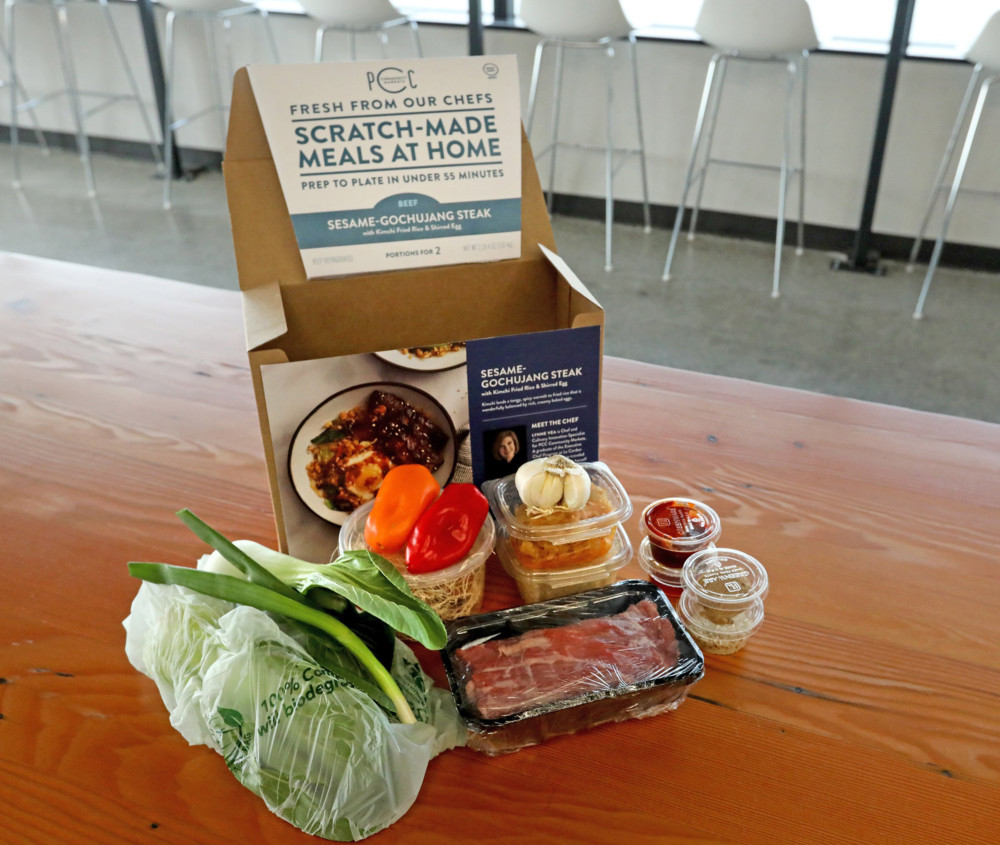By Benjamin Romano
The Seattle Times
WWR Article Summary (tl;dr) While subscription-based services that ship meal kits to people’s homes are convenient, some customers are frustrated by the amount of packaging they come with (ice packs and insulation materials). Grocery stores are now trying to address that issue with their own ready-to go products.
SEATTLE
If you want pre-portioned ingredients and recipes to cook and eat at home, your array of choices is growing.
As online meal-kit pioneers such as Blue Apron struggle for profitability, the grocery industry they sought to disrupt, from national giants to local chains, is getting into the business.
PCC Community Markets, the Seattle-based co-op focused on local and organic food, begins its meal-kit program Wednesday, seeking to stand out in a crowded field with recipes developed in-house, with high-quality ingredients, boxes packed in its stores daily and minimal packaging.
That follows QFC’s local introduction April 1 of the Prep+Pared meal kits that parent company Kroger began testing last summer.
Next month, Portland-based chain New Seasons Market will debut its meal kits.
Albertsons, the Boise, Idaho-based consolidated grocery giant, took a different route into the meal-kit business last fall when it acquired Plated, one of Blue Apron’s largest competitors.
Amazon, too, is active. The online commerce giant began selling its own meal kits last summer, and offers them at its Go store. It also teamed up with Allrecipes.com last fall to deliver ingredients from certain popular recipes via AmazonFresh.
PCC Chief Executive Cate Hardy said grocery stores are “uniquely positioned to win in meal kits.”
While subscription-based services that ship meal kits to people’s homes are convenient, some customers are frustrated by the amount of packaging they come with, ice packs and insulation materials necessary to keep ingredients cool en route.
The subscription model also locks people in to a regular cadence of deliveries, which can be desirable until your plans change and unmade kits start filling the fridge. They also get knocked as pricey.
Grocery stores offer meal-kits to take home and use that night, or to order online and have delivered, with less packaging and more flexibility and choice, said Hardy and other grocery executives.
“The pioneers in this space, the Blue Aprons and the Plateds, they’ve hit upon something that’s really interesting to consumers and appealing to them,” said Neil Stern, a retail analyst and senior partner at Chicago-based retail consultancy McMillanDoolittle. Still, their model has shown substantial shortcomings. “They’re growing but they haven’t figured out how to make money yet,” he said.
Blue Apron, the New York-based market leader in meal kits, started in 2012 and went public last year. It reported sales of $187.7 million in last year’s fourth quarter, down 13 percent from a year earlier, on a 15 percent decrease in customers, which the company attributed to “substantially scaled back” marketing. It lost $39.1 million in the quarter.
Some 10.5 million U.S. households, 9 percent, had purchased a meal kit in the prior six months, according to a Nielsen survey taken late last year. Nearly two-thirds of meal-kit buyers have so far purchased exclusively online, the survey found.
In-store meal-kit sales reached $154.6 million in 2017, according to Nielsen. That’s up 26 percent, but it’s only a tiny fraction of the $374 billion Americans spent on grocery, dairy, and frozen foods in brick-and-mortar grocers.
With that kind of built-in customer base, grocers don’t have to spend money to attract shoppers, which has been “the Achilles’ heel” of the online competitors, Stern said.
Meal kits are available to match a wide range of tastes, cooking-skill levels, diets and budgets. In entering the business, PCC sought to develop a unique version that would appeal to its local customers.
Chef Lynne Vea relied on nearly two decades of teaching cooking classes at PCC to help hone recipes she said are not too difficult, but still exciting to the epicures among the co-op’s shoppers.
“After teaching for all these years, you get to know what people love,” Vea said.
The co-op plans to rotate the selection to highlight seasonal ingredients in its stores, where the kits will be assembled each day. Its six initial offerings, which sell for about $10 per serving, include a Korean-style flap steak with fried rice and a vegetarian red-lentil curry with jasmine rice and halloumi cheese.
PCC also put a lot of effort into packaging.
“Our kits are not going to leave our shoppers feeling like they’ve just contributed to the problem,” Hardy said.
“Everything in the package, with the exception of the Saran wrap on the meat, is either going to be compostable or recyclable.”
Grocers see the kits boosting sales, executives said they expect customers picking up kits to buy side dishes and beverages to round out the meal, and keeping themselves relevant by adopting an innovative approach to cooking.
“What we’re looking for is that it drives more shopping occasions, more trips,” said QFC division president Suzy Monford, adding that she expects meal kits to be “an add-on in the basket, not a replacement.”
The kits sold in some 20 area QFC stores are packed by FreshRealm, which recently opened a facility in Sumner, she said. (In an another indication of the potential the industry sees for this model, FreshRealm describes offerings including “an eCommerce platform designed to turn any retail brand, category merchant, celebrity chef or lifestyle tastemaker into a viable meal-kit business.”)
The rush into meal kits is another example of grocery stores trying new responses to threats from online business models, in this case, borrowing a page from the erstwhile disrupters themselves.
“They’re still being disrupted, in a way,” Stern said. “What they show (with meal kits) is they do have the ability to respond.”














































































































































































































































































































































































